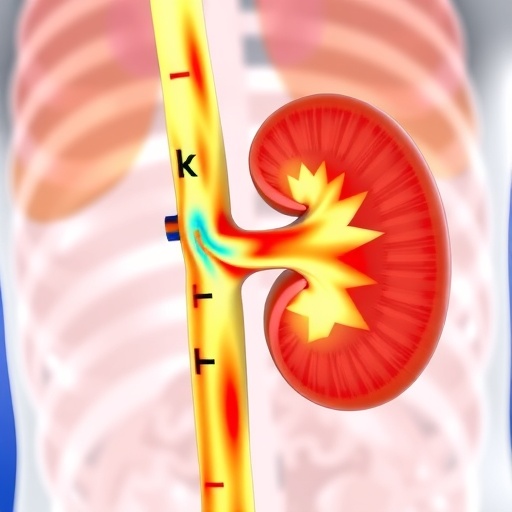
In a groundbreaking advancement at the intersection of pediatric nephrology and artificial intelligence, researchers have unveiled a sophisticated real-time risk prediction model aimed at identifying acute kidney injury (AKI) in hospitalized pediatric patients. This innovation promises to transform the way clinicians approach early diagnosis and intervention for one of the most pressing complications in hospitalized children worldwide. Acute kidney injury, characterized by a sudden decline in renal function, often escalates into severe clinical outcomes if not promptly recognized and managed. The newly developed model employs cutting-edge computational techniques to analyze diverse patient data streams, providing clinicians with an unprecedented tool to anticipate AKI onset before irreversible organ damage occurs.
The development of this real-time risk prediction algorithm marks a significant stride forward from traditional diagnostic methods, which often rely on retrospective assessments and overt clinical manifestations. By leveraging machine learning frameworks and integrating dynamic vital signs, laboratory data, and demographic factors, the model exhibits remarkable predictive accuracy. Such an approach epitomizes precision medicine’s promise, tailoring risk assessments to individual patients and enabling timely, personalized therapeutic strategies. Moreover, the model’s validation across multi-center pediatric cohorts emphasizes its robustness and adaptability to varied clinical settings, a crucial factor for widespread clinical utility.
Central to the model’s architecture is an ensemble of features extracted from electronic health records (EHRs), encompassing biochemical parameters indicative of renal function, vitals reflecting hemodynamic status, and demographic variables like age and comorbid conditions. This holistic data integration facilitates a nuanced understanding of the multifactorial etiology of AKI in children, whose pathophysiology often diverges from adult patients due to unique developmental and metabolic factors. The model employs sophisticated statistical learning algorithms to weigh these parameters in real time, distinguishing subtle clinical changes that presage renal injury, often overlooked by human assessment in busy hospital wards.
.adsslot_OGn0ACX9Sw{width:728px !important;height:90px !important;}
@media(max-width:1199px){ .adsslot_OGn0ACX9Sw{width:468px !important;height:60px !important;}
}
@media(max-width:767px){ .adsslot_OGn0ACX9Sw{width:320px !important;height:50px !important;}
}
ADVERTISEMENT
The researchers meticulously addressed the challenge of data heterogeneity and missingness intrinsic to clinical datasets by incorporating imputation techniques and rigorous feature selection processes. This not only ensured model stability but also enhanced interpretability, allowing clinicians to discern which factors predominantly influenced risk estimates in individual cases. The interpretability of predictive models remains a crucial consideration in clinical decision support systems, fostering trust and facilitating informed medical judgments. Consequently, the model does not function as a black-box system but provides transparent risk profiles and potential intervention levers.
Validation of the model was carried out with an extensive pediatric patient population from multiple tertiary hospitals, encompassing diverse age groups, diagnoses, and treatment modalities. Such wide-ranging validation datasets strengthen the generalizability and external validity of the findings, reinforcing confidence in the model’s application across heterogeneous healthcare environments. Importantly, the real-time nature of the model enables it to continuously update risk predictions as new clinical data become available, thereby maintaining relevance throughout the patient’s hospital stay and dynamically adapting to evolving physiological states.
One of the remarkable aspects of this research is the incorporation of real-time data streaming from bedside monitoring devices and EHR integration, enabling seamless assimilation of continuous patient data. This dynamic data integration allows the model to provide early warnings hours or even days prior to clinically overt AKI, presenting a window of opportunity for pre-emptive measures such as fluid management adjustments or nephrotoxic medication dose modifications. The potential to significantly reduce morbidity and mortality through such anticipatory interventions could dramatically improve pediatric care outcomes and reduce healthcare costs associated with prolonged hospitalizations and renal replacement therapies.
The clinical implications of this risk prediction model extend beyond mere early detection. By stratifying patients according to their individualized risk trajectories, the healthcare team can prioritize resource allocation, optimize monitoring intensity, and tailor treatment plans more judiciously. Pediatric patients at high predicted risk for AKI can be subjected to more stringent renal function surveillance, dietary modifications, and nephrotoxin avoidance strategies, whereas low-risk individuals may benefit from less intensive interventions, thereby minimizing unnecessary medical procedures and fostering a more patient-centered approach to care.
Given the complexity and variability of pediatric AKI etiologies—including dehydration, sepsis, cardiac surgery, and exposure to nephrotoxic agents—the model’s comprehensive variable inclusion enables nuanced risk estimations that can capture these diverse causative pathways. Furthermore, the model accounts for temporal correlations and physiological trends over time, integrating temporal dimension insights which are critical in understanding disease progression patterns. This temporal modeling capability bolsters predictive precision and helps avoid both false positives and false negatives, which are significant concerns in clinical risk assessments.
The integration of this predictive model in clinical workflows is facilitated by its user-friendly interface and compatibility with existing hospital information systems. Real-time risk alerts are designed to appear within clinician dashboards, paired with actionable recommendations derived from evidence-based guidelines. Such embedded decision support minimizes workflow disruptions and enhances clinician uptake, a pivotal factor for successful implementation of technological innovations in healthcare. Moreover, continuous feedback loops within the system allow ongoing model refinement based on accumulating clinical experience and data, fostering a learning health system environment.
Ethical considerations were thoroughly addressed during model development, including patient data privacy, informed consent, and algorithmic fairness. The team ensured that the model did not inadvertently perpetuate healthcare disparities by validating performance across various subpopulations stratified by factors such as age, sex, ethnicity, and underlying comorbidities. This commitment to equity aligns with the broader goal of advancing health outcomes universally among vulnerable pediatric populations and underscores the responsible integration of AI in medicine.
Beyond immediate clinical usage, this risk prediction tool holds significant research utility. It enables retrospective cohort stratifications to study AKI pathophysiology and the impact of various interventions, potentially guiding future therapeutic trials. Additionally, real-time predictions can identify candidate patients for enrollment in clinical studies focused on AKI prevention or treatment, accelerating the pace of discovery. The model’s openness to integration with other predictive frameworks in pediatric critical care portends an era of multimodal risk assessment, enhancing holistic patient management.
This innovation also exemplifies the transformative potential of artificial intelligence within pediatric healthcare. Unlike adult-centric predictive models, which often cannot be directly transferred to children due to developmental differences, this pediatric-specific approach acknowledges and adapts to the unique clinical landscape of childhood. Consequently, it sets a precedent for similar AI-powered tools targeting other pediatric conditions where early detection is vital, such as sepsis, respiratory failure, or neurodevelopmental disorders.
Looking ahead, the researchers plan to expand model capabilities through incorporation of genomics and metabolomics data, aiming to refine risk stratification further. Integration with telemedicine platforms could also enable remote monitoring of at-risk patients post-discharge, extending the benefits of early AKI risk detection beyond the hospital setting. Such longitudinal tracking may prove invaluable in preventing recurrent kidney injury and mitigating chronic kidney disease progression, a devastating sequela in children who survive acute insults.
In conclusion, the development and validation of this real-time AKI risk prediction model herald a paradigm shift in pediatric nephrology. By harnessing the power of real-time data analytics, machine learning algorithms, and seamless clinical integration, this tool empowers clinicians with actionable foresight into renal injury risk in hospitalized children. As the model moves toward routine clinical application, it is poised to significantly improve morbidity and mortality outcomes associated with AKI and to catalyze further innovations in pediatric AI-driven healthcare solutions.
Subject of Research: Acute Kidney Injury (AKI) risk prediction in hospitalized pediatric patients.
Article Title: Development and validation of a real-time risk prediction model for acute kidney injury in hospitalized pediatric patients.
Article References:
Zhang, C., Wang, C., Hu, QS. et al. Development and validation of a real-time risk prediction model for acute kidney injury in hospitalized pediatric patients. World J Pediatr (2025). https://doi.org/10.1007/s12519-025-00950-2
Image Credits: AI Generated
DOI: https://doi.org/10.1007/s12519-025-00950-2
Tags: artificial intelligence in nephrologycomputational techniques in medicinedynamic patient data analysisearly diagnosis of kidney injuryintervention strategies for AKImachine learning for pediatric patientsmulti-center clinical validationpediatric acute kidney injurypediatric nephrology advancementspersonalized medicine in pediatricspredictive analytics in healthcarereal-time risk prediction model





